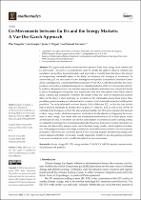Por favor, use este identificador para citar o enlazar este ítem:
https://repositorio.usj.es/handle/123456789/619
| Título : | Co-Movements between Eu Ets and the Energy Markets: A Var-Dcc-Garch Approach |
| Autor: | Gargallo Valero, Pilar



Lample Gracia, Luis Javier 


Miguel, Jesús A 

Salvador, Manuel Juan 

|
| Palabras clave : | Climate change; EU ETS; Energy markets; VAR-DCC-GARCH; Impulse response analysis; Minimum risk portfolio |
| Fecha de publicación: | 28-jul-2021 |
| Editorial : | MDPI AG |
| Citación : | Gargallo, P.; Lample, L.; Miguel, J.A.; Salvador, M. Co-Movements between Eu Ets and the Energy Markets: A Var-Dcc-Garch Approach. Mathematics 2021, 9, 1787. https://doi.org/10.3390/math9151787 |
| Resumen : | This paper analyzes the co-movements of prices of fossil fuels, energy stock markets and EU allowances. This analysis is conducted in order to identify the spillover effect of volatility and correlation among these financial markets, and to provide a scientific basis that shows the interest of incorporating sustainable assets in the design of minimum risk strategies of investment. To achieve this goal, we have used a Vector Autoregressive-Dynamic Conditional Correlation-Generalized Autoregressive Conditional Heteroscedasticity (VAR-DCC-GARCH) model that also incorporates a stock index of industrial companies as a leading indicator of the level of economic activity. In addition, the paper conducts an impulse response analysis to determine how unexpected shocks to prices are propagated along time, and, in particular, how they affect prices of the others, both in mean, variance and correlation. Therefore, the results of this one- and two-dimensional analysis allow for the study of short and long run dynamics of the relationship among those prices, thus, providing greater meaning and information for investors, which has implications for building their portfolios. The analyzed period was from January 2010 to February 2021, so that the data include half of phase II, full phase III and the onset of phase IV of the EU ETS, as well as the COVID-19 outbreak in the European context. We also analyzed whether the EUA price impulses the demand of clean energy stocks, which has important implications for the objective of triggering the investment in clean energy. Our results show the transmission mechanism of all of those prices, which are relevant not only for investors but also for policymakers to construct an early-warning system, revealing the most important transmission channels. Moreover, from an investment viewpoint, we observe a decline in dirty energies and a rise in the clean energy market, which might be an indication of the progress towards the energy transition to renewables sources within a circular economy perspective. Therefore, this shows that the EU ETS is achieving its goals, and that clean energy companies, aligned with their role towards socially responsible initiatives, are also gaining acceptance in terms of investments, which would be beneficial for the environment. |
| URI : | https://repositorio.usj.es/handle/123456789/619 |
| ISSN : | 22277390 |
| Aparece en las colecciones: | Artículos de revistas |
Ficheros en este ítem:
| Fichero | Descripción | Tamaño | Formato | |
|---|---|---|---|---|
| Co Movements between Eu Ets and the Energy Markets.pdf | 1,84 MB | Adobe PDF |  Visualizar/Abrir |
Este ítem está sujeto a una licencia Creative Commons Licencia Creative Commons

